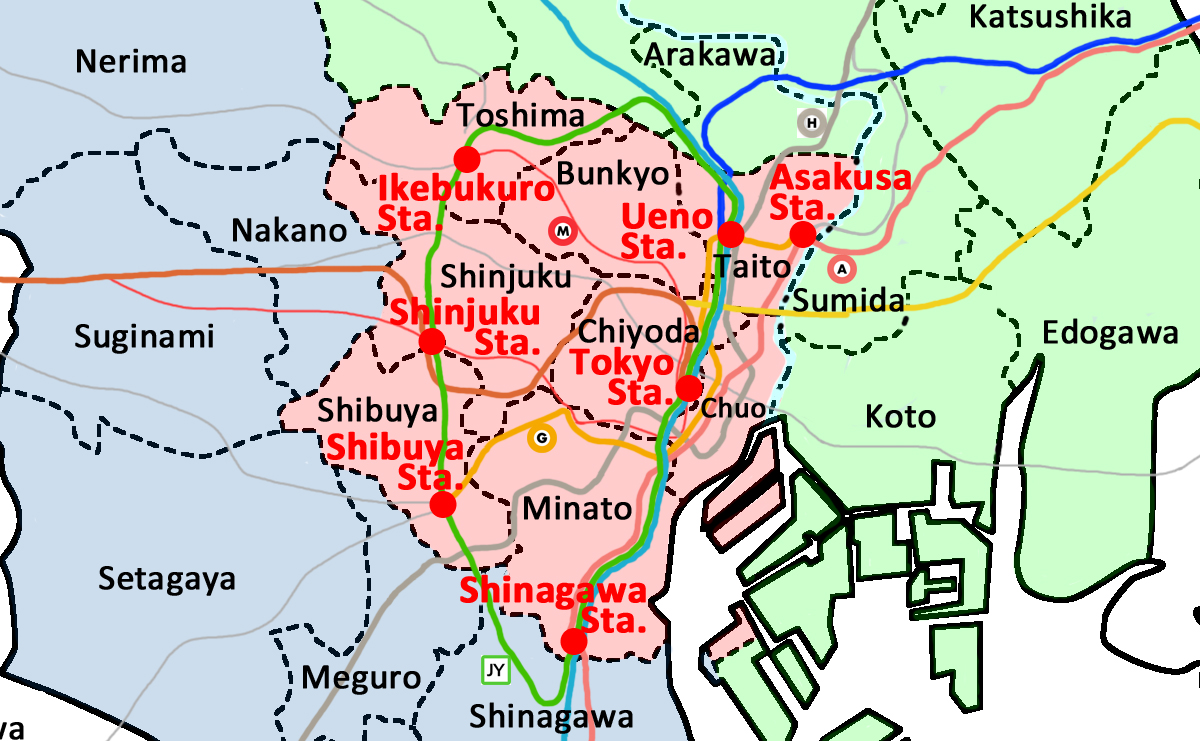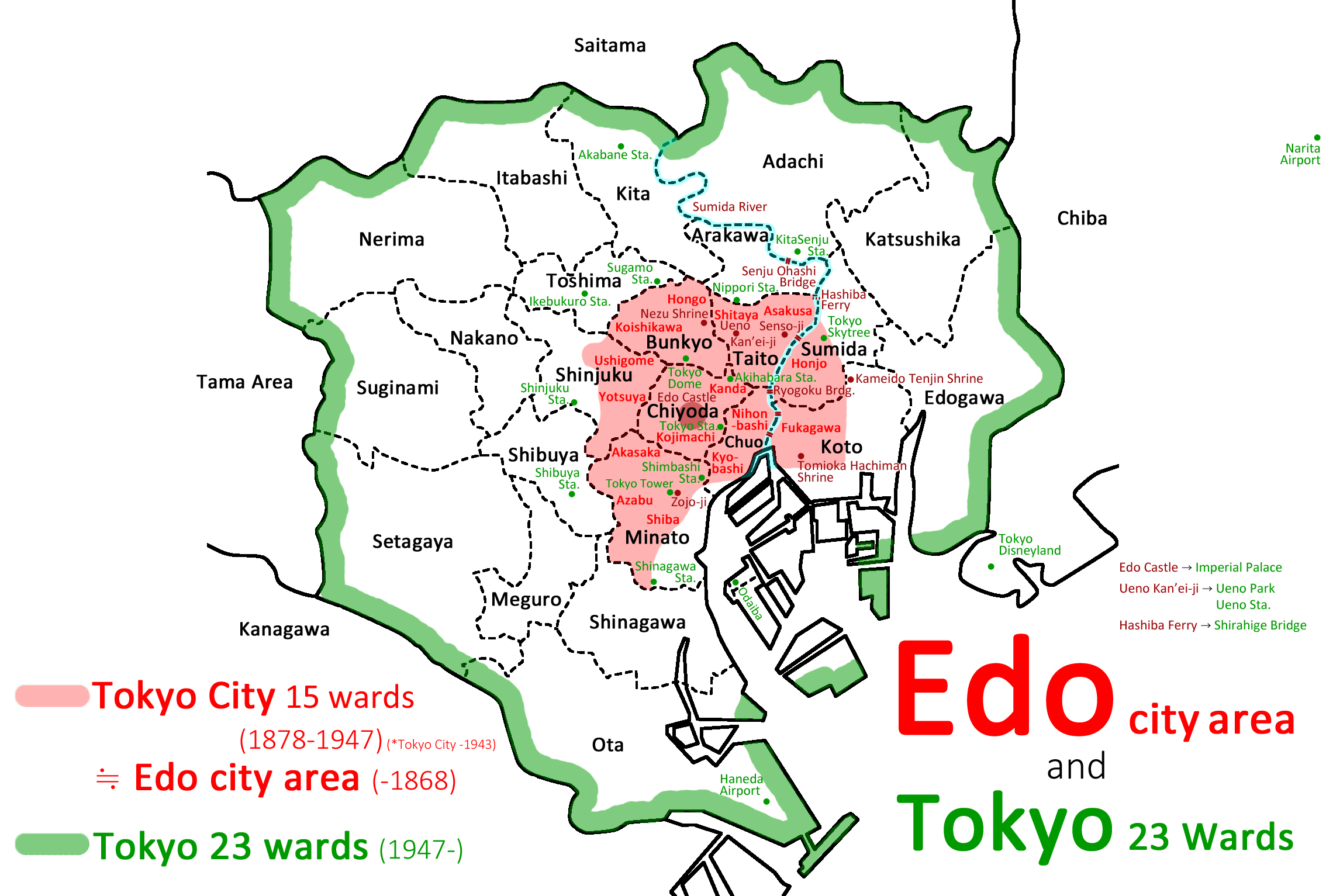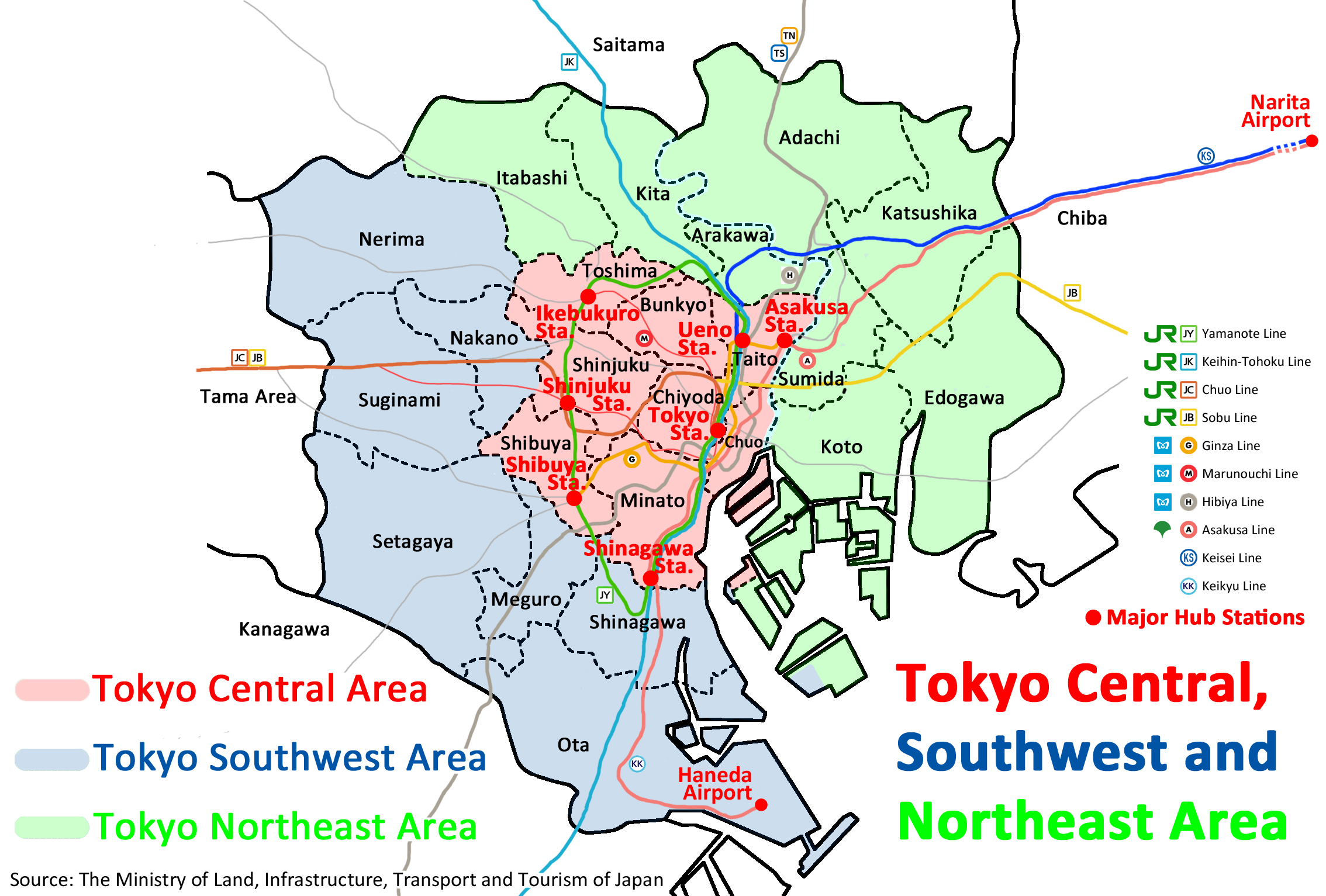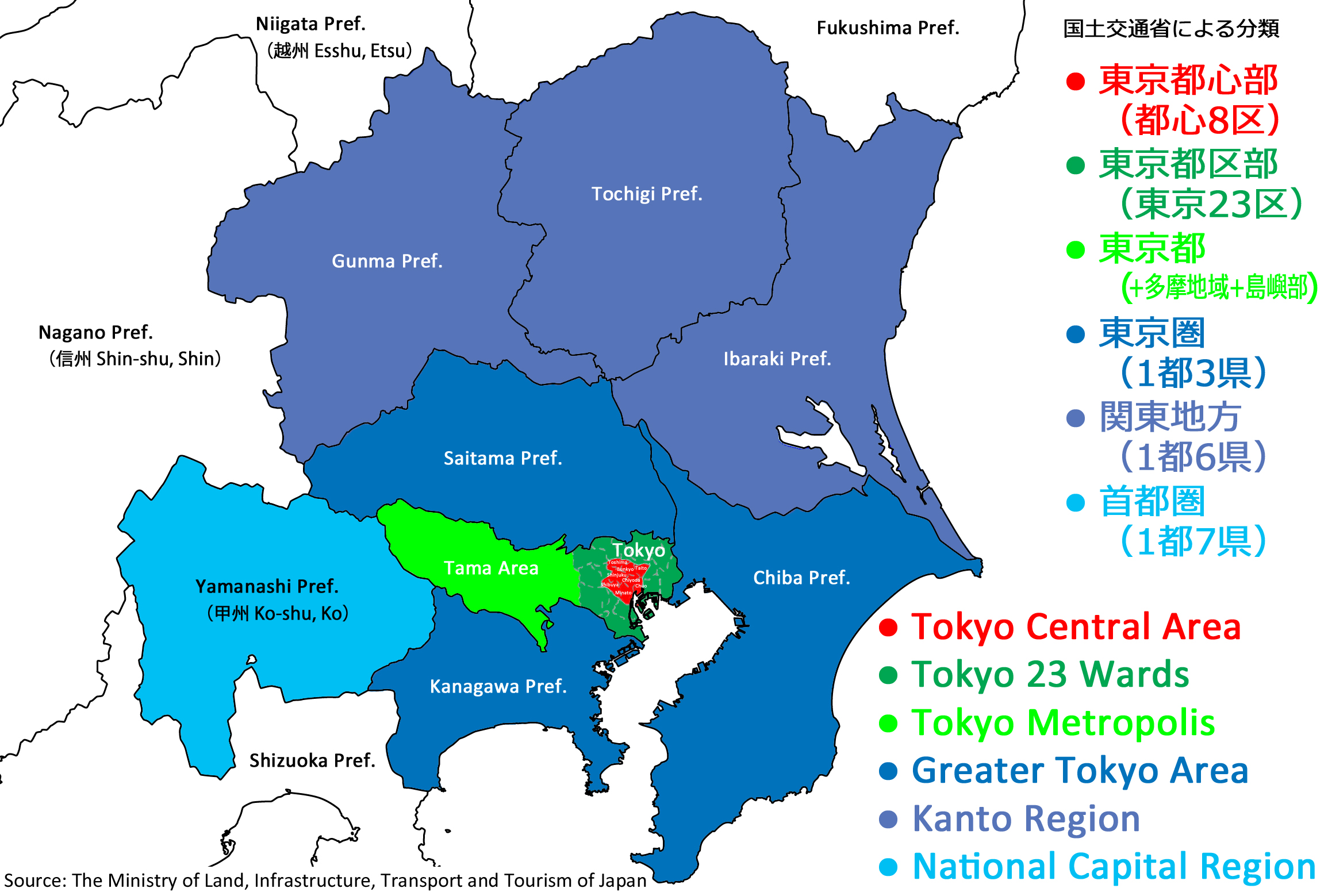History of Tokyo

Many people (especially from other prefectures including current governor of Tokyo and current mayor of Taito-ward who decided to stop the Tokyo Jidai Matsuri Festival like this and that) may think that the history of Tokyo began in 1603 when Tokugawa Ieyasu established the Edo shogunate, but that is the history of Tokyo “as a capital” or the history of small limited area around “Edo Castle”.
The true History of Tokyo started from the Sumida River and Asakusa area at the 7th Century. Asakusa has been there before Edo. When most of the south-east area of Tokyo (including from Tokyo Sta. to Shinagawa Sta.) was under the sea and most of the west area was in the vast wilderness of mountains, Asakusa was the only town with urban function in Tokyo area. Senso-ji was worshiped by many people including Taira clan, Minamoto clan, Ashikaga clan, Hojo clan and then, Tokugawa clan.
Asakusa Senso-ji (628-)
In the beginning was the River Sumida and then Asakusa Senso-ji.
In 628 during the Asuka period (592-710), the oldest temple in Tokyo, Asakusa Senso-ji was built to enshrine a statue of the Kannon found in the Sumida River. Asakusa at that time was a small fishing village along the Sumida River. It grew bigger and bigger as increasing number of people visited to worship Senso-ji.
Musashi Province (7th Century-)
Just before the Nara period (710-794), Musashi Province (current Tokyo, Saitama and a part of Kanagawa) was established and the Sumida River was the border between Musashi and Shimousa Provinces. And Go-ki Shichi-do (5 provinces, 7 regions and 7 major highways) were built, one of them Tokaido highway (old Tokaido was a different route from that of the Edo period) passed the northern Asakusa, and Hashiba Ferry was built across the Sumida River. It was an important point of traffic between the north and the west capital Nara, as the first and only official Ferry across the Sumida River for a long time since then, and a post station town was developed around there.
Ariwara no Narihira (9th Century)
In the early Heian period (794-1185), the Sumida River with Hashiba Ferry became famous nationwide by the poem: na ni shiowaba /iza koto towan / miyakodori / waga omou hito wa / ari ya nashi ya to by Ariwara no Narihira (one of the Six Poetic Geniuses) and the Tales of Ise.
And many poems related to the Sumida River were written since then, and the words “kototou” and “Miyako-dori” started to imply “the Sumida River in East Japan” among the court nobles in the capital, like this famous poem by Nijo Ishi in the Gyokuyo Wakashu and the Meisho Waka Hyakunin Isshu: koto toedo / kotaenu tsuki no / Sumida gawa / miyako no tomo to / miru kai mo nashi.
Taira clan (10th Century)
After Taira no Takamochi was appointed to Kazusa Province as a governor in 898, Taira clan started to dominate the whole Kanto region including Tokyo area.
Taira no Masakado was the first samurai who led a rebellion in the Kanto region against the Imperial government of Kyoto and declared himself the “New Emperor” in 939, but was defeated. Masakado’s severed head was brought to the future site of Edo and buried, now its mound Masakado-zuka is located beside the Imperial Palace in Tokyo, and that spot is long considered untouchable because of Masakado’s curse. Masakado was enshrined in Kanda Myojin Shrine later.
Masakado’s Rebellion devastated Senso-ji. But it was rebuilt and Kaminarimon, Five-Storied Pagoda and other facilities were newly built in 942 by his cousin Taira no Kinmasa, the governor of Musashi Province (who was also a cousin of an ancestor of Taira no Kiyomori, the first samurai who dominated the government of Kyoto in the late Heian period). Tokyo area was firstly developed by Taira clan, and Asakusa was the only temple town with many craftsmen and urban function in Tokyo area at that time.
Minamoto clan and others (11th-16th Century)
After the revolt of Taira no Tadatsune was ended by Minamoto no Yorinobu in 1028, Minamoto clan started to dominate the whole Kanto region.
After 20 years since Minamoto no Yoshitomo was defeated by Taira no Kiyomori in Kyoto, his son Minamoto no Yoritomo raised a new army in 1180, recruited allies in the Kanto region, ordered Edo Shigenaga to make the first bridge temporarily across the Sumida River, and pledged to avenge his father’s death at Senso-ji (he planted a Ginkgo tree at Senso-ji and it still stands there today). He finally defeated Taira clan in the Genpei War and founded the Kamakura shogunate (1185-1333) in 1185, the first shogunate in Japan and the first government in Kanto region.
Yoritomo moved Minamoto clan’s most important shrine to its present location and reconstructed as Tsurugaoka Hachimangu with the help of craftsmen from Asakusa. Wakamiya Oji, the main approach of the shrine and the main avenue of Kamakura city, was constructed to head toward the direction of the north-east Senso-ji to demonstrate Yoritomo’s great devotion.
The 33 Temples of Bando (= Kanto) Kannon Pilgrimage were selected by Yoritomo and his son Sanetomo after the Saigoku Kannon Pilgrimage, Senso-ji was the only temple in Tokyo.
Also Yoritomo’s father Yoshitomo (who dedicated a Kannon statue to Senso-ji that still exists today), other leaders in the Kamakura period, the succeeding Ashikaga Takauji, other Shoguns of Ashikaga shogunate in the Muromachi period (1338-1573) and Hojo clan in the Azuchi-Momoyama period (1573-1603) demonstrated great devotion to Senso-ji.
Edo Castle (1457-)
Edo (literally means “bay entrance”) at that time was only a small bay area’s name southwest from Asakusa. A minor offshoot of the Taira clan, Chichibu Shigetsugu moved their residence to that place and called himself Edo at the 12th Century, that was the beginning of the Edo clan. His son Edo Shigenaga became one of the allies of Minamoto no Yoritomo and built a bridge across the Sumida River then. After the Edo clan left, Ota Dokan (statues), a retainer of the Uesugi clan under the Ashikaga shogunate, built Edo Castle there in 1457.
After Uesugi and Hojo clan, Tokugawa Ieyasu moved from Sunpu Castle to Edo Castle and designated Asakusa Senso-ji as a tutelary temple of the Tokugawa clan in 1590. And Ieyasu made Senju Ohashi Bridge at the north of Asakusa, the only bridge across the Sumida River that leads to the north in 1594. Ieyasu used to have a great respect for Yoritomo (and he used to claim himself as one of the descendants of the Minamoto clan), so he prayed for the victory of the Battle of Sekigahara at Senso-ji, and won in 1600.
Edo Period (1603-)
Tokugawa Ieyasu established the government, Tokugawa shogunate in Edo in 1603. Edo became the de facto capital of Japan.
Edo Castle at that time was surrounded by Kanda-yama Plateau (current Ochanomizu, leads to Hongo Plateau), Hibiya Bay (current Tokyo Sta, Yurakucho Sta and Shimbashi Sta), Edo-maejima Peninsula (current Nihonbashi Sta, Kyobashi Sta and Ginza Sta) and shallow waters (See the Before and After Map). Ieyasu cut down Kanda-yama Plateau, brought the soil to Hibiya Bay to reclaim land expanding flat area, and developed a new town Edo-honcho (later Nihonbashi) and turned a ridge road of the peninsula into a new Tokaido highway that leads to the west Kyoto. Some rivers were diverted, and several protective moats and logistical canals were built.
At that time an old superstition used to be prevalent that the direction of the northeast is Kimon (demons’ gate) and the southwest is Ura-kimon (the back demons’ gate), and the capital should be protected by great temples or shrines to stop demons from entering from these gates (like Enryaku-ji at the northeast of Kyoto and Iwashimizu Hachimangu Shrine at the southwest of Kyoto, Nara and Kamakura are the same).
Now many people misunderstand Kimon as “a source of bad luck” but that is completely opposite, Kimon was rather considered to be the most sacred direction and the most powerful spiritual place.
So Edo Castle was built to be protected by the northeast Senso-ji, Ieyasu moved Zojo-ji to the southwest of Edo Castle in 1598, and his grandson, the 3rd shogun, Tokugawa Iemitsu newly built Kan’ei-ji on Mount Ueno at the northeast of Edo Castle in 1625.
Many cherry trees were transplanted from Mount Yoshino in Nara to Mount Ueno, and Ueno has become the prime cherry blossom spot in Edo since then.
Shiba Zojo-ji and Ueno Kan’ei-ji were the 2 most important Tokugawa family temples in Edo, each temple holds the 6 remains of 15 Tokugawa shoguns (the 1st Ieyasu in Kunozan, the 3rd in Nikko, and the last 15th in Yanaka). Nikko Toshogu, Kunozan Toshogu and Ueno Toshogu are said to be the 3 greatest Toshogu which enshrine Ieyasu.
The four greatest towers in Edo (Edo Yon-to) were Five-Storied Pagodas in Asakusa Senso-ji, Ueno Kan’ei-ji, Yanaka Tenno-ji and Shiba Zojo-ji (the last two were burned later and don’t exist now).
All roads led to Nihonbashi, from all around Japan. 4 post station towns along the 5 major highways, the first ones about 8 kilometers distant from Nihonbashi, were Senju-shuku to the north, Itabashi-shuku to the north-west, Naito-Shin-juku (almost current Shinjuku Station) to the west and Shinagawa-juku to the south-west (“shuku/juku” means “lodging”).
Edo city area expanded beyond the Sumida River after the Great Fire of Meireki in 1657 to build the 2nd bridge on the Sumida river, Ryogoku Bridge and build new towns, Honjo and Fukagawa (“Ryogoku” means “both provinces”, those areas beyond the Sumida River were in another province at that time). Reclaimed land continued to expand, Tsukiji was also built on reclaimed land at that time (Tsukiji means “constructed land”). Edo grew to become one of the largest cities in the world.
There were only 5 bridges across the Sumida River (then also called O-kawa, the “Great River”) at that time (currently more than 30 bridges), Senju Ohashi Bridge to the north, Ryogoku Bridge to Honjo, Shin-Ohashi Bridge from central Nihonbashi, Eitai Bridge to Fukagawa and Azuma-bashi Bridge from Asakusa.
The Edo culture flourished and the cultural centers of Edo were the 3 greatest Hirokoji (broad main street), Asakusa Hirokoji (the street in front of Senso-ji, current Kaminarimon Street, Edo Map is here), Ueno (Shitaya) Hirokoji (the street in front of Kan’ei-ji, current Chuo Street, from Ueno station to Ueno Hirokoji station, Matsuzakaya is still here) and Ryogoku Hirokoji (mainly current Higashi Nihonbashi).
The most famous poet in Japan, Matsuo Basho wrote in 1687:
Hana-no kumo, Kane-wa Ueno-ka Asakusa-ka
(Cloud of cherry blossoms; the temple bell of time tolls, from Ueno or Asakusa?)
The first fireworks festival in Japan was held on the Sumida River in 1733. It was held by the 8th shogun, Tokugawa Yoshimune, to pray for the end of the Kyoho famine and mourn for the dead.
Now it is a yearly tradition in July-end, it is also considered as a “send-off fire” of Obon for many Tokyo locals.
Tokyo (1868-)
The Edo Period ended in 1867, the Meiji Era started, Edo was renamed Tokyo and became a prefecture in 1868. Tokyo Prefecture (-fu) initially consisted only of the former Edo city area.

Original Tokyo City 15 wards (1878-1932)
15 wards (-ku, in 1878) and Tokyo City (-shi, in 1889) were established.
Tokyo City 15 wards area has always been the central city area from the Edo period through to the Meiji, Taisho and Showa eras.
Original 15 wards of Tokyo City (former Edo city area):
Kojimachi, Kanda (current Chiyoda), Nihonbashi, Kyobashi (parts of current Chuo),
Shiba, Azabu, Akasaka (parts of current Minato), Yotsuya, Ushigome (parts of current Shinjuku),
Koishikawa, Hongo (current Bunkyo), Shitaya, Asakusa (current Taito),
Honjo (a part of current Sumida), Fukagawa (a part of current Koto)
Current 8 wards of original Tokyo City (former Edo city area): Chiyoda, Chuo, Minato, Shinjuku, Bunkyo, Taito (Chiyoda and the five adjacent wards), Sumida and Koto (added area after the Great Fire)
The territory of Tokyo Prefecture was expanded beyond Edo in several steps to reach roughly its present extent, comprised of Tokyo City, suburban districts and Tama area.
Greater Tokyo City 35 wards (1932-1947)
Surrounding districts were added as 20 new wards to the central 15 wards, total 35 wards.
In 1943, Tokyo City merged with Tokyo Prefecture to form Tokyo Metropolis (-to).
Tokyo 23 wards (1947-)
35 wards were consolidated into 23 wards.

Tokyo Central Area (Inner Tokyo, Tokyo Core Area, Central Tokyo 8 wards): Chiyoda, Chuo, Minato, Shinjuku, Bunkyo, Taito (Chiyoda and the five adjacent wards), Shibuya and Toshima (added area after 1947)
Tokyo Southwest Area: Shinagawa, Meguro, Ota, Setagaya, Nakano, Suginami and Nerima
Tokyo Northeast Area: Sumida, Koto, Kita, Arakawa, Itabashi, Adachi, Katsushika and Edogawa
(Areas are classified by the Ministry of Land, Infrastructure, Transport and Tourism of Japan)
For your information, in Central Tokyo, Chiyoda, Chuo, Minato, Shibuya, Bunkyo, and Taito wards prohibit smoking in public places throughout the wards.
Thus, Tokyo Metropolis consists of Tokyo 23 wards, Tama Area and the islands.
The Tokyo Megalopolis Region, or Greater Tokyo Area, is made up of Tokyo and the three neighboring prefectures of Saitama, Chiba, and Kanagawa.
The National Capital Region is made up of Tokyo and the seven surrounding prefectures of Saitama, Chiba, Kanagawa, Ibaraki, Tochigi, Gunma, and Yamanashi.
And when we say “Kanto-Ko-Shin-Etsu“, that means Kanto Region, Yamanashi (Ko), Nagano (Shin) and Niigata (Etsu).

Development of Tokyo
The first railway line in Japan was made to connect Yokohama Port to Shimbashi through Shinagawa Port to carry freight in 1872. Shinagawa Station was built on reclaimed land at the south end of Tokyo City and the line from Shinagawa to Shimbashi Station was built on the sea like this. (Btw, Shinagawa Station is in current Minato-ku, not in current Shinagawa-ku. “Minato” means “port”.)
Nippon Railway, the first private railway company in Japan (current JR), made Ueno Station in 1883 and a line to connect to the northern part of Japan through Akabane Station. Soon after the end of the Edo period, the Boshin War occurred and most of Ueno Kan’ei-ji was destroyed in 1869, it turned into the first park in Japan, Ueno Park in 1873 and offered the place for Ueno Station.
Ueno Park became the cultural center of Tokyo City, the first museum in Japan opened in Ueno Park in 1872, the first Industrial Exhibition in Japan was held in Ueno Park in 1877, and the first zoo in Japan opened in Ueno Park in 1882.
They wanted to connect Shimbashi Station to Ueno Station, but it was hard to construct a line through the core center of the city, current Minato, Chiyoda and Taito-ku, so in the meantime they made a line along the outside of the western border of Tokyo City from Shinagawa Station to Shibuya, Shinjuku and Akabane Station to carry freight in 1885.
After that they connected Ueno Station to Ikebukuro Station, then Shimbashi Station to Tokyo Station, and finally central parts, Ueno Station to Tokyo Station to form Yamanote Line in 1925.
After that, new private railway companies have started to make many new lines starting from the Yamanote Line stations. And Tokyo has started to develop westward along the Yamanote Line, and many Tokyo’s major city centers have been created along this circle forming the heart of Tokyo. Thus, the Yamanote Line that circles Central Tokyo has become the most famous, important and busiest train line in Japan and an iconic symbol of Tokyo.
While in Asakusa, the first movie theater in Japan opened in 1903. And Ryounkaku, the tallest building in Japan at that time with the first elevator in Japan, was built in 1890. Here is a film of Asakusa (and Ueno) at that time. Ryounkaku was destroyed by the Great Kanto earthquake in 1923. After the Quake, Ginza was newly developed and flourished as a symbol of civilization. And after the railways were heavily damaged by the Quake, Haneda Airport opened in 1931.
In 1945, Asakusa-ku has the largest population in Tokyo City, followed by Honjo, Kanda, Shitaya, Arakawa, Nihonbashi and so on. Mainly those areas were burned by the Bombing of Tokyo.
The first subway line in Asia opened from Asakusa – Tawaramachi – Inaricho – Ueno to connect the 2 most popular towns in Tokyo City at that time in 1927. The line was extended to Nihombashi – – Ginza – Shimbashi – – Shibuya and was named Ginza Line in 1953. After that, Marunouchi Line (Ikebukuro – – Tokyo – Ginza – – Shinjuku), Toei Asakusa Line (AsakusaBashi – Kuramae – Asakusa – HonjoAzumabashi – Oshiage) and Hibiya Line (NakaOkachimachi – Ueno – Iriya – Minowa – MinamiSenju) opened by 1961, to connect current major hub stations in Tokyo.
Tokyo Tower was built in Shiba in 1958, the first Tokaido Shinkansen was built and the first Olympics in Asia was held in Tokyo in 1964.
From 1970s, Shinjuku, Shibuya and Ikebukuro started to flourish as new city centers. Narita International Airport opened in 1978 and Tokyo Disneyland opened in 1983. In 1980s, Roppongi flourished as a symbol of boosting economy. In 1991, the Tokyo Metropolitan Government moved from Marunouchi (a district between Tokyo Station and the Imperial Palace) in Chiyoda-ku to the current building in Shinjuku-ku. In 2000s, Odaiba flourished as an amusement spot with many attractions.
Now, Tokyo (JR w/Shinkansen, Metro), Shinjuku (JR, Metro, Toei, Keio, Odakyu, Seibu), Shibuya (JR, Metro, Keio, Tokyu), Ikebukuro (JR, Metro, Tobu, Seibu), Shinagawa (JR w/Shinkansen, Keikyu), Ueno (JR w/Shinkansen, Metro, Keisei), and Asakusa (Metro, Toei, Tobu, Tx, Cruise) are the 7 major hub stations in Tokyo. And these Asakusa, Ueno, Tokyo, Shinagawa, Shibuya, Shinjuku, and Ikebukuro are the Tokyo 7, the most prosperous areas in Tokyo that make up Central Tokyo.
Tokyo Skytree, the tallest structure in Japan, the tallest tower in the world, was built in 2012. Tokyo Skytree uses the vibration suppression technology used in Five-Storied Pagodas. Tokyo Skytree Station’s former name was Narihira-bashi Station that was named after Ariwara no Narihira (the former name of Narihira-bashi Station was simply Asakusa Station. Kototoi Dango, Kototoi Bridge and Kototoi Street were also named after his famous poem). The height of 634 m was selected from the figures 6 (mu), 3 (sa), 4 (shi), that stands for “Musashi” Province. The CEO said that they used to have another idea, “628” m, the year of the foundation of Asakusa Senso-ji, the year when the history of Tokyo began.
